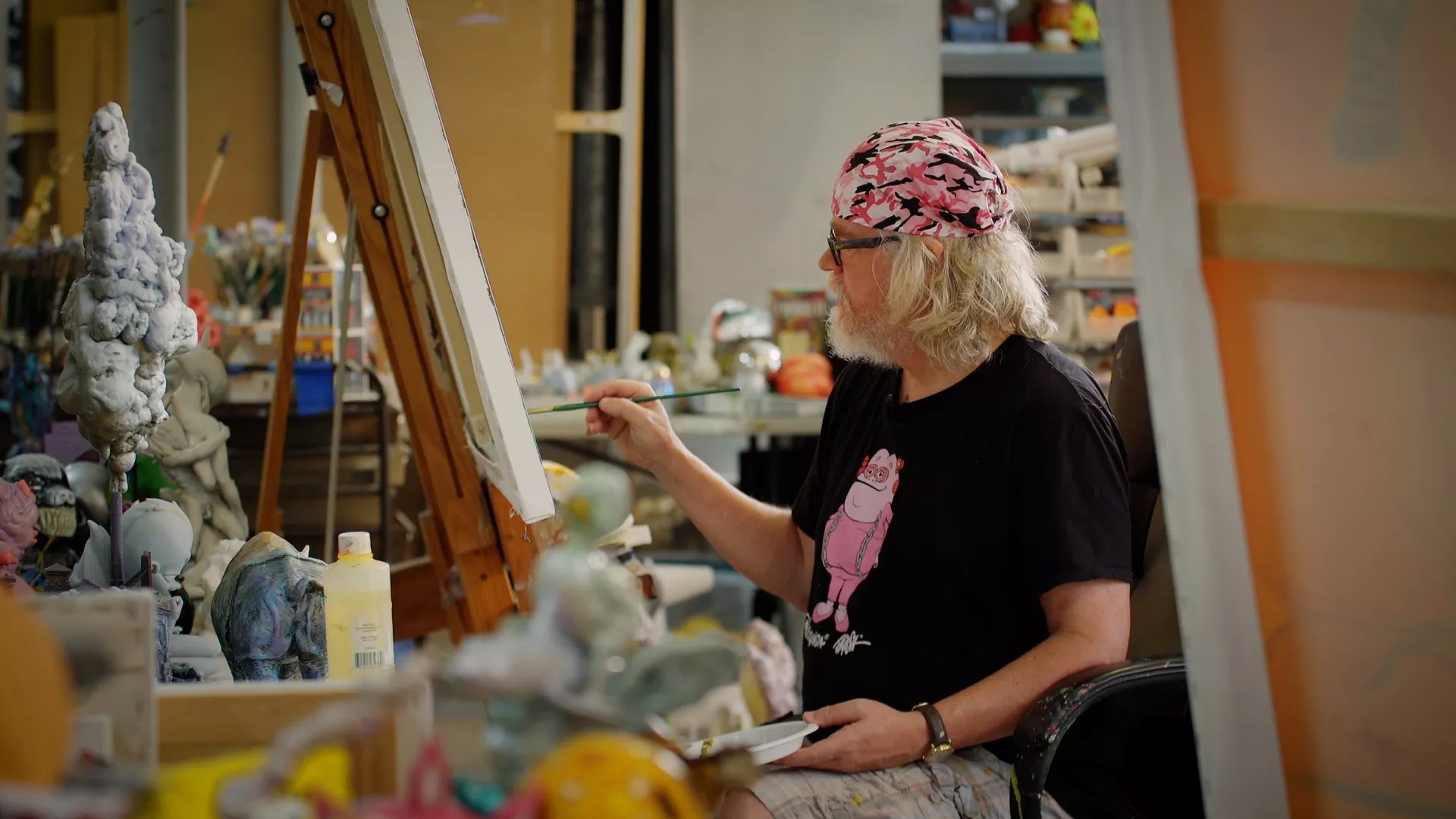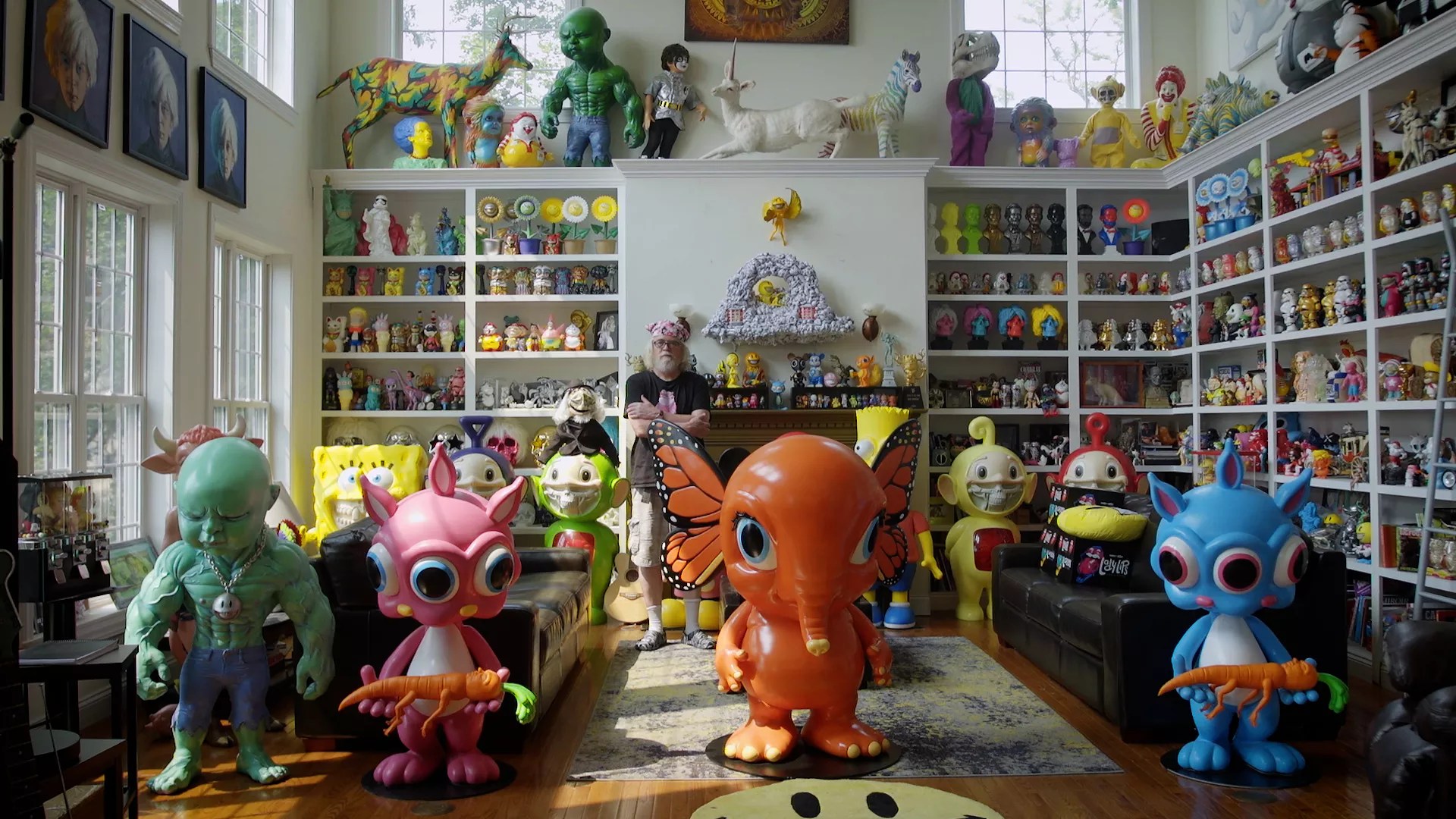
Constant van Hoeven/Mr. Kaleidoscope Productions

Audio By Carbonatix
Through his movement of “POPaganda,” Ron English has created an array of merry mascots that poke fun at the foibles of corporate America – among them MC Supersized (a rotund Ronald McDonald-esque clown) and a skeletal take on Charlie Brown named “Grin.” No wonder the painter has been described as “Norman Rockwell on acid.”
There are no sacred cows in English’s world, although there is a sexy, udder-breasted pinup named Cathy Cowgirl. Yet his irreverent canvases, collectible vinyl toys and larger-than-life sculptures critique commerce as adeptly as they embrace it. It’s a big reason why he’s inspired the generation of talent that came up behind him. Without English, there would be no Banksy, no Shepard Fairey, no Kaws – the latter even began his career assisting English as a teen.
“At some point, you realize if you do something in public, people are going to imitate it. It’s not a good thing or a bad thing; it’s just a thing,” he says of his outsized influence. “My trick was to stay in the game. I did street art in the ’70s, and back then, there was no social media, so there was no way to see how people were reacting, but, one day, street art became the biggest thing in the world, so I’m not going to walk away from it now. You realized, ‘Now they want to pay me 100 thousand dollars instead of putting me in jail.'”
English began exploring the medium as a college student at the University of North Texas in the late 1970s. He’d plant fake products in local grocery stores or take over empty warehouses in Deep Ellum for events, charging a cover at the door. Noticing tons of empty billboards scattered around Texas highways, he also began tagging them with his work – at least until the police charged him with a second-degree felony.
Will you step up to support Dallas Observer this year?
At the Dallas Observer, we’re small and scrappy — and we make the most of every dollar from our supporters. Right now, we’re $14,000 away from reaching our December 31 goal of $30,000. If you’ve ever learned something new, stayed informed, or felt more connected because of the Dallas Observer, now’s the time to give back.
After earning his MFA at the University of Texas in Austin, English moved to New York to pursue his career in earnest, working as a truck driver and apprenticing with other painters as he pasted his creations over advertisements around the city. Once he realized others were getting credit for his ideas, he shifted from making anonymous work to pursuing his place in tony galleries. English was one of the first painters to straddle the fine and commercial art worlds, diversifying into figures and toys before they were an obvious artistic outlet.
“[Robert] Rauschenberg and [Jasper] Johns did windows on Fifth Avenue before they were successful with their paintings, but the art world was so uptight,” he says. “If you were getting any commercial work, you weren’t going to be in the art world. The guy who broke that didactic was Keith Haring. He got famous so fast he didn’t know how rarified he was. Of course, he wanted a store that sells T-shirts. It should have gotten him 86’d, but then it went in the other direction and opened up the industry. The idea of being able to do album covers is a cool thing now; it’s just another feather in your cap.”
English has painted album covers for The Dandy Warhols, Slash and Chris Brown and has been featured in multiple documentaries, plus an episode of The Simpsons. Having been the subject of the 2005

Some of the colorful works of Ron English, which are the subject of yet another film.
Constant van Hoeven/Mr. Kaleidoscope Productions
documentary Popaganda: The Art and Crimes of Ron English, he’s now the star of yet another film, Welcome to Delusionville, a more personal look at his life and oeuvre that recently screened at the Kessler Theater.
Dutch director Constant van Hoeven, who released Delusionville under the moniker Mr. Kaleidoscope, originally planned on making a film about graffiti art when he realized English was the most exciting subject of all.
“Ron takes in American culture, and he inhales the American dream and shows the American nightmare,” van Hoeven says. “Ron is in touch with something more than normal people, he taps into things we don’t see, and one of those things is American culture. He sees through it and sees the truth behind it.”
Filming was anticipated to take six months but has expanded into six years, with the director still tweaking the final result. Having won Best Documentary at the D.C. Independent Film Festival, van Hoeven plans on entering the film into next year’s South by Southwest and seeding it to a streaming service such as Hulu or Netflix.
Delusionville draws its title from an alternate world dreamed up by English, peopled by aliens, rabbits, wolves, vultures, pigs, ducks, turtles and MC Supersized. The multi-layered story has led to a book, songs, trading cards and a Meow Wolf-style installation touring in two different iterations throughout Europe and China called respectively Out of Delusionville and Sugar Circus.
“The idea was to create something I could exploit in multiple ways for the rest of my life, so I don’t have to keep looking at different things to do,” says English. “It’s an immersive thing with two hundred people dressed up like the different Delusionville characters, and at the end, we’re able to make money with a giant gift shop. As the metaverse becomes more realized, we can make it into bigger events. We’re negotiating to do it in Vegas and Miami, and they’re looking at Dallas.”
And, with the entire English family involved in the business – wife Tarssa manages his negotiations, and kids Zephyr and Mars work in product development and as the artist’s crypto club manager – English hopes it’ll keep them all busy for years to come. In the meantime, the artist has signed a deal to bring his work to one of the places it began – he’s slated to create a mural on a Deep Ellum wall this fall.
“We did this idea in Deep Ellum 40 years ago,” he says. “We didn’t have subways, so we did all this crazy art on billboards and used them as a giant art gallery and did crazy installations in old warehouses. It’s Texas; we do things bigger, we got space, we think big, so all this crazy Ron English attitude was born in Texas.”